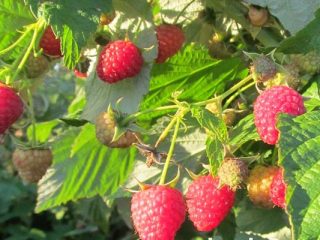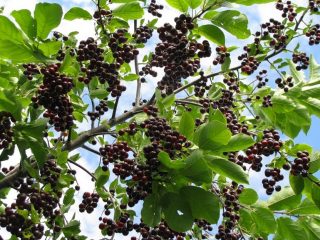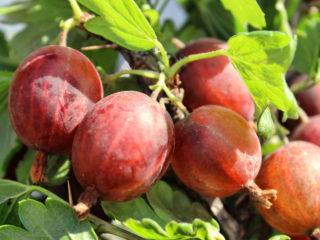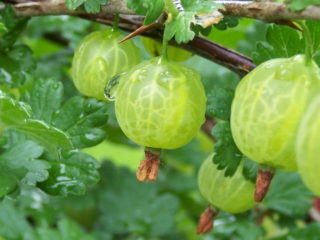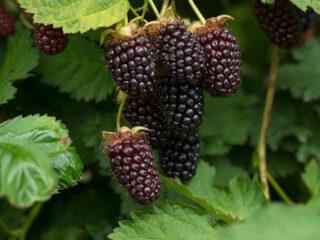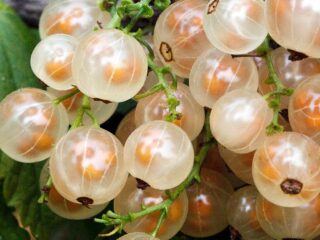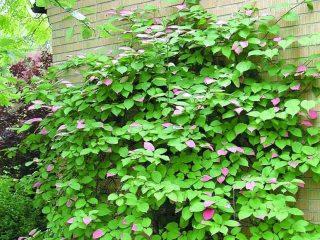Content
Umbrella sucker is similar in appearance to sea buckthorn, but, unlike it, it has red berries. The plant is also known as Akigumi. The plant is a tall shrub, undemanding to environmental factors. It is used in landscape design and folk medicine. Fruits, flowers and leaves have beneficial properties.
Description and photo of umbrella sucker
The culture reaches 2-4 m in height, the rate of development is average. Umbrella sucker is partially self-fertile, so at least two different varieties are required to get a good harvest. The plant got its name because of its spreading crown, which is made up of flexible long branches. Already at a young age, small spines form on them.
Unlike other plants of this genus, the umbrella variety has light green, almost light green leaves. They extend 5-10 cm and have a lanceolate shape. There are tiny hairs on the back of the plates, which is why the bush appears silvery in suitable lighting.
Silvery-golden inflorescences exude a distinct aroma.It attracts pollinating insects.
The buds form ovaries from which fruits appear.

The ripening period lasts about 4-5 months
Young berries are gray-brown, mature ones are ruby red.
The size of the fruit is small, only 7 mm. Most of it is occupied by the bone. The pulp is sweet, which is explained by the 22% sugar content. Also present are vitamins B, C and E, calcium, phosphorus, fats, ascorbic acid. Umbrella oleaster is popular due to its high yield - up to five buckets of berries are harvested from one mature bush.
The plant begins to bear fruit at the age of 8 years. Candied fruits, jellies, and wines are prepared from the fruits. The harvest can be consumed fresh.
Where does it grow
Elf umbellata grows in abundance in Japan and China. It can also be found in other countries with warm climates. In Russia, the plant is grown in the Caucasus, Crimea, and Krasnodar. Many gardeners cultivate Elf umbrella in temperate latitudes. In this case, the plantings are covered for winter.
Beneficial properties of Elefon umbellata
Akigumi is a plant with a high content of vitamins, most of which are concentrated in the berries. Based on them, decoctions and medicines are prepared that are useful for the treatment of colds and inflammation. The shoots are used as an antibacterial and antiviral agent.
The leaves and flowers are collected in June. They are dried outside or in dryers (at a temperature of +45 degrees). The material can be stored for up to two years, after which the medicinal properties decrease.
Infusions are prepared from the leaves for patients suffering from fever. Externally used for radiculitis and gout.It has been noted that with long-term use of shoots, patients experience improved memory and relief of malaria symptoms.
Berries are especially useful for people with heart and vascular problems. The juice strengthens the walls of blood organs and produces a tonic effect. Dry fruits help cope with unstable stools.
Advantages and disadvantages
Umbrella oleaster has a number of useful properties, and both fruits and leaves with flowers are equally valuable.

The plant looks beautiful against the background of ornamental crops
Pros:
- can be grown in different climate zones;
- resistance to diseases and pests;
- attracting pollinating insects;
- moderate growth, frequent haircuts are not required.
Minuses:
- Umbrella gooseberry is not able to grow in cold regions without shelter.
Features of growing umbrella elf
This variety of plant is most often grown from seeds. They are sold in bags. Such seeds are disinfected, so they do not require additional processing. You can sow in autumn or spring; in each case, stratification should be done: for this, the seeds are placed in a container with wet sand and placed in the refrigerator; Optimal storage temperature is +5 degrees.
The seeds have good germination, about 90-95%. By the way, the probability of successful rooting of cuttings is 95-98%. After preparation, the raw materials are buried in the ground to a depth of 20 mm. When shoots appear, the container with the umbrella oleagin is moved to a bright windowsill and protected from direct sunlight.Until the roots grow, the grower is required to water and weed the soil.
At the end of the growing season, the seedlings will grow up to 20 cm in height, and the roots will grow to the sides of the pot. After a year, the umbrella gooseberry is transplanted into open ground.

When planting plants, maintain a distance of 1.5 m between them.
If you grow the umbellate gooseberry with seeds, the harvest can be expected in the fourth year. However, the plant will gain strength only by the eighth year of life. On average, productivity lasts about 20 years, and the lifespan of the plant is more than 50 years.
Umbrella sucker is undemanding and only needs watering and pruning. To increase productivity, it is recommended to apply fertilizing. But this is not a prerequisite for growing.
The shrub is able to tolerate short-term colds down to -10 degrees and long-term colds up to -5 degrees, so in the fall it needs shelter. Otherwise, the upper shoots will be damaged.
In October, the umbrella oleaster is bent to the ground, covered with burlap or buried at partial height. In warm climates, oleaster is grown as an evergreen crop; in cold climates, as a deciduous plant.
Reproduction methods
Umbrella elf is obtained not only from seeds. Cuttings of bushes proceed quite quickly. The plant is also propagated by root suckers. The last method is the most effective, as it gives results in the shortest possible time. However, this requires a mature shrub.
Diseases and pests
The species practically does not get sick and is not affected by insects.Strong immunity is characteristic of the entire Loch genus.
Application in landscape design
The umbrella variety has a spreading crown, so sun-loving plants are not planted next to it. Of interest to designers are mature shrubs that are covered with reddish berries in summer or early autumn.
The crop can be grown at home as a dwarf tree.

The plant is used to form hedges

Saplings tolerate shearing well, so they are used to make decorative fences
Conclusion
Umbrella oleaster, or akigumi, is a shrub with edible fruits. The latter are highly valued in folk medicine. Infusions, decoctions, and teas are prepared based on the berries. The harvest is used in winemaking.


